Louisiana is a popular state known for its vast system of swamps and bayous. Thanks to the watery habitat, it’s also home to many fascinating animals, including snakes. With approximately 47 species of snakes in the state, then you’re sure to come across one at some point. Seven are these snakes are venomous and one of the most common is the distinctive cottonmouth. So join us as we learn all about cottonmouths in Louisiana, including where they live, what they look like, and how likely you are to get bitten by one!
What do Cottonmouth Snakes look like?
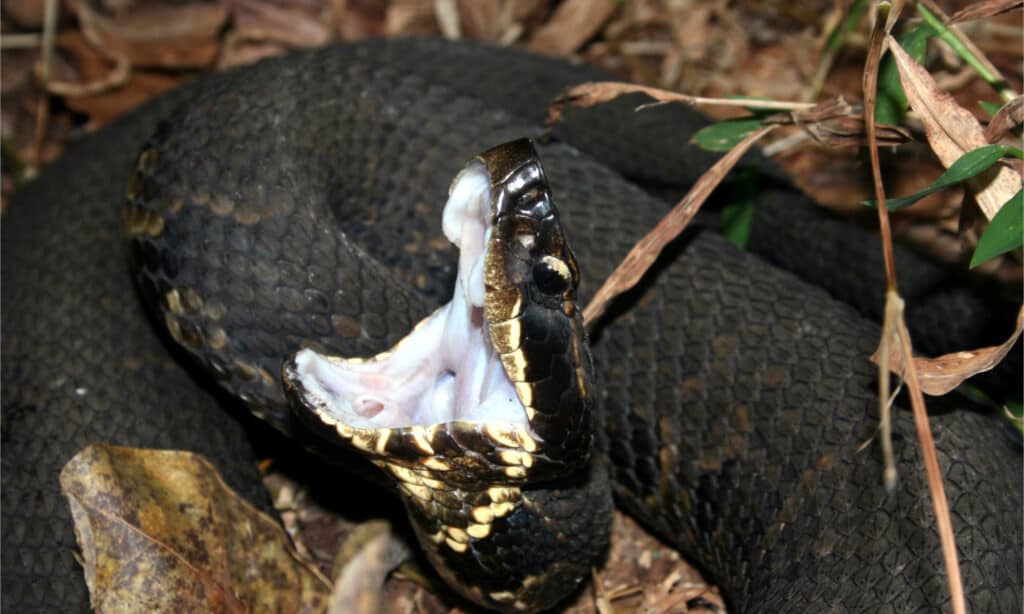
The cottonmouth snake has a white lining in its mouth.
©Psychotic Nature/Shutterstock.com
Cottonmouths are found across the majority of the southeastern area of the United States. There were originally three subspecies – western, eastern, and Florida cottonmouths. The Florida cottonmouth was reclassified as a distinct species in 2014, while the other two were combined into a single species – the northern cottonmouth (Agkistrodon piscivorus). The Florida cottonmouth lives only in Florida and the southern region of Georgia, while the northern cottonmouth is found across the rest of the cottonmouth’s range – including in Louisiana.
The northern cottonmouth (simply cottonmouth from here on in this article), is a large snake that measures 30 to 42 inches long. These snakes have dark brown to black bodies with darker crossband markings. Older cottonmouths often become completely black, and their markings are virtually impossible to see.
However, it’s also important to know how to identify a juvenile cottonmouth as they don’t actually look the same as adults. While adults are always dark-colored, juvenile cottonmouths are much lighter. They have a light brown ground color which is overlaid with reddish-brown crossbands. Their color then tends to darken as they get older. However, the other distinguishable feature of a juvenile cottonmouth is the tip of its tail which is bright yellow.
Despite this, the main distinguishing feature of any cottonmouth snake – young or old – is the mouth. And while looking at the mouth of a venomous snake isn’t the best way to identify it, this is actually where cottonmouths get their name from. This is because the lining of the inside of their mouth is bright white which resembles cotton. Usually, this is most often seen when they adopt a defensive posture, but we’ll discuss that in more detail later.
Where are the Cottonmouths in Louisiana?
Cottonmouths are one of the most abundant venomous snakes in Louisiana and they live statewide. As they are semi-aquatic snakes, cottonmouths are most often (although not always) found near a permanent source of water. Slow-moving water including swamps, bayous, streams, ponds, and even ditches are particularly favored by these snakes.
Due to their aquatic nature, cottonmouths are also called “water moccasins”. As they spend a lot of time in the water, there are a few other (harmless) water snakes that look like cottonmouths. Unfortunately, these snakes are sometimes killed simply because they look like venomous snakes. The northern water snake is frequently misidentified as a cottonmouth.
Cottonmouth Venom
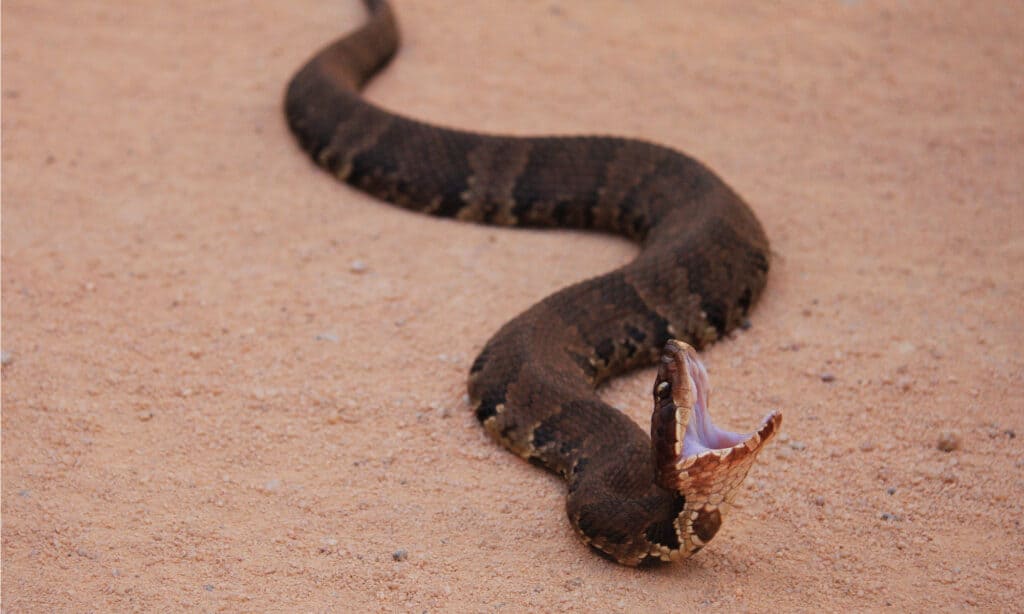
The cottonmouth venom is cytotoxic.
©Nathan A Shepard/Shutterstock.com
There are three main types of snake venom – cytotoxic, neurotoxic, and hemotoxic. Cytotoxic venom is found in most pit vipers – including cottonmouths. Although cytotoxic venom isn’t as deadly as some of the other types, it still causes some serious problems.
One of the main issues with cytotoxic venom is how it damages tissue. This powerful venom can cause extensive blistering, apoptosis (cell death), and necrosis (tissue death). In the most severe cases, amputation can be required.
As well as having potent venom, cottonmouths contain a large quantity of venom. Every bite contains an average of 125mg of venom, although in some individual cases, this figure can range as high as 237mg.
How Often Are People Bitten by Cottonmouths in Louisiana?
There are 7,000 to 8,000 snake bites every year in the US from venomous snakes, resulting in an average of five deaths. Of these, cottonmouths are only responsible for a minute number of them at around 1%.
There are no reliable records that state how often cottonmouths actually bite in Louisiana so we can’t honestly say how often they bite. However, what we can explain is that under normal circumstances (not being threatened or harassed) cottonmouths do not want to bite you — preferring to flee instead. Most bites from venomous snakes actually happen when they are stood on. However, as cottonmouths are semi-aquatic then there is always a risk while in the water too.
If you come across a cottonmouth snake, then you will likely see it adopt the defensive posture that we mentioned earlier. This involves them coiling themselves with their mouth wide open exposing that bright white lining.
What Should you do if you Come Across a Cottonmouth?
If you do come across a cottonmouth snake – and especially one that is in the defensive posture – then the main thing you need to remember is to move slowly away. Do not panic and do not attempt to run or make and quick movements as these will only aggravate the snake.
If you are between a cottonmouth and a body of water, then calmly move out of the way as the water is where the snake will want to head to for safety. By moving away and allowing the snake room to move towards the water, you are also showing that you are not a threat, which will reduce the likelihood of the snake feeling as though it needs to defend itself.
How Should You Treat a Cottonmouth Bite?
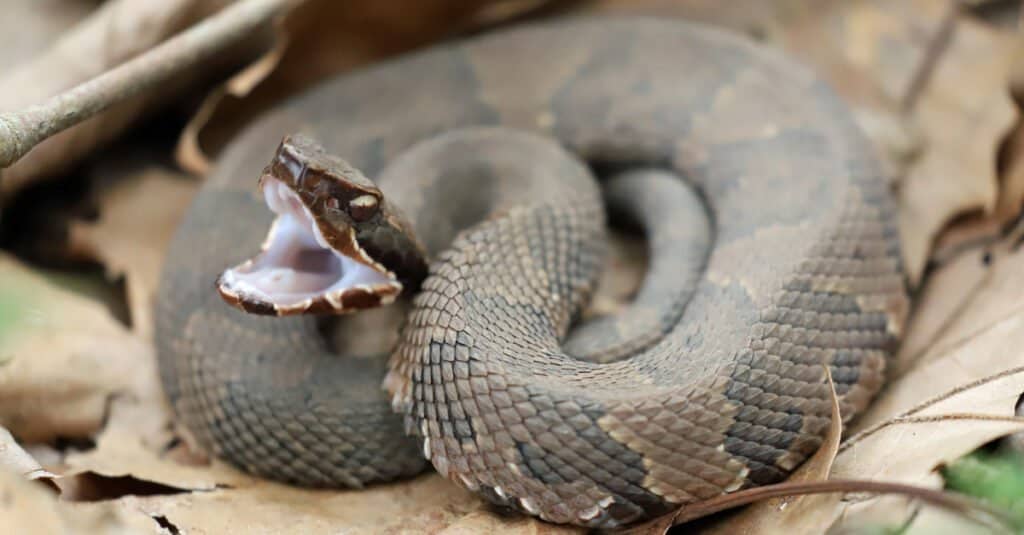
Seek medical help immediately if bitten by a cottonmouth.
©KF2017/Shutterstock.com
Unfortunately, bites do occur – especially as cottonmouths are so widespread across Louisiana. As we mentioned earlier, even though the venom from a cottonmouth isn’t considered to be as deadly as that produced by several other snakes, it is still dangerous. Therefore, time is of the essence and you should seek medical help immediately. Although the bite might not seem to be that bad, it can get worse quickly if left untreated. Luckily, there is anti-venom to treat cottonmouth bites, and in most cases, it does work successfully.
You might know stories about removing snake venom from a wound yourself. However, this is not something that you should ever do. Instead, simply keep the affected limb elevated above heart level while you wait for medical help. Don’t put any ice on the wound, no matter how painful it is.
Other Aquatic Snakes in Louisiana
Although there are six other venomous snakes in Louisiana, given the abundance of cottonmouths in the state across aquatic habitats we thought we’d mention a few of the other snakes that are easily mistaken for cottonmouths – namely water snakes.
Northern Water Snake (Nerodia sipedon)
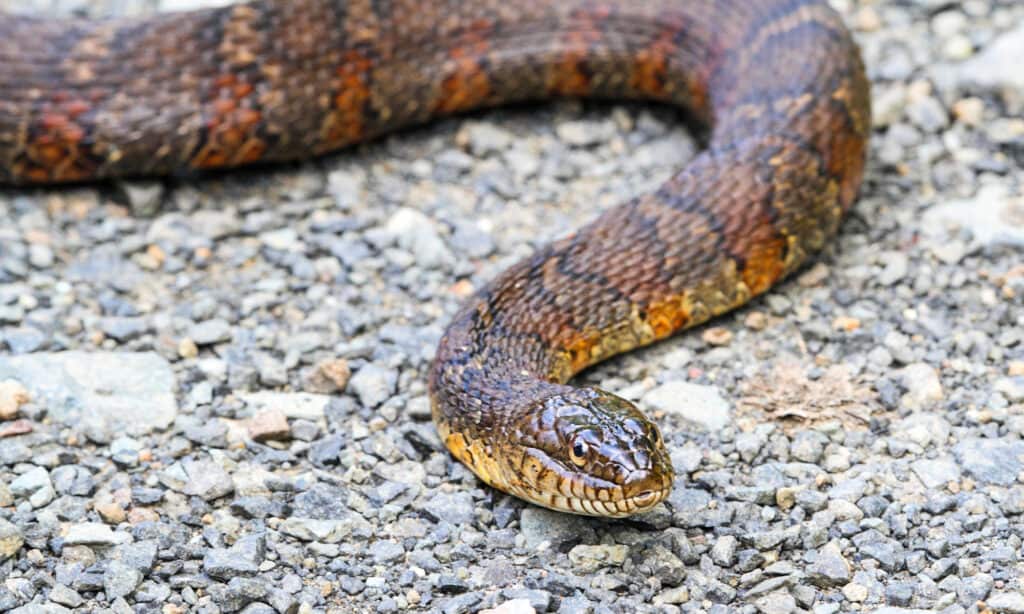
Northern water snakes are mistaken for cottonmouths.
©Steve Byland/Shutterstock.com
The northern water snake and one of its subspecies – the midland water snake (Nerodia sipedon pleuralis) – are both commonly mistaken for cottonmouths. These snakes typically have reddish-brown to brownish-black bodies with dark crossbands on their neck and blotches on their bodies. They live in and around slow-moving water where they prey on a range of fish, frogs, and lizards.
Diamondback Water Snake (Nerodia rhombifer)
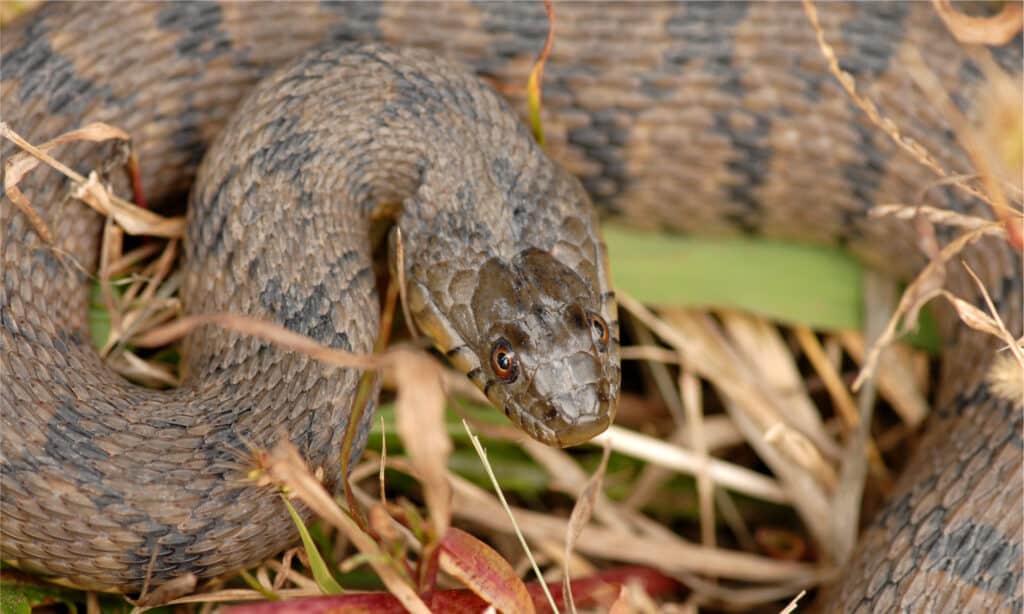
Diamondback water snakes are mistaken for cottonmouths.
©Rusty Dodson/Shutterstock.com
The diamondback water snake is 30 to 48 inches long and has a brown or dark brown body with black blotches down its back and sides which are connected by diagonal black lines. Diamondback water snakes live in any freshwater habitats, but prefer areas with plenty of overhanging vegetation. When threatened, they sometimes flatten their neck and body while hissing violently.
Banded Water Snake (Nerodia fasciata)
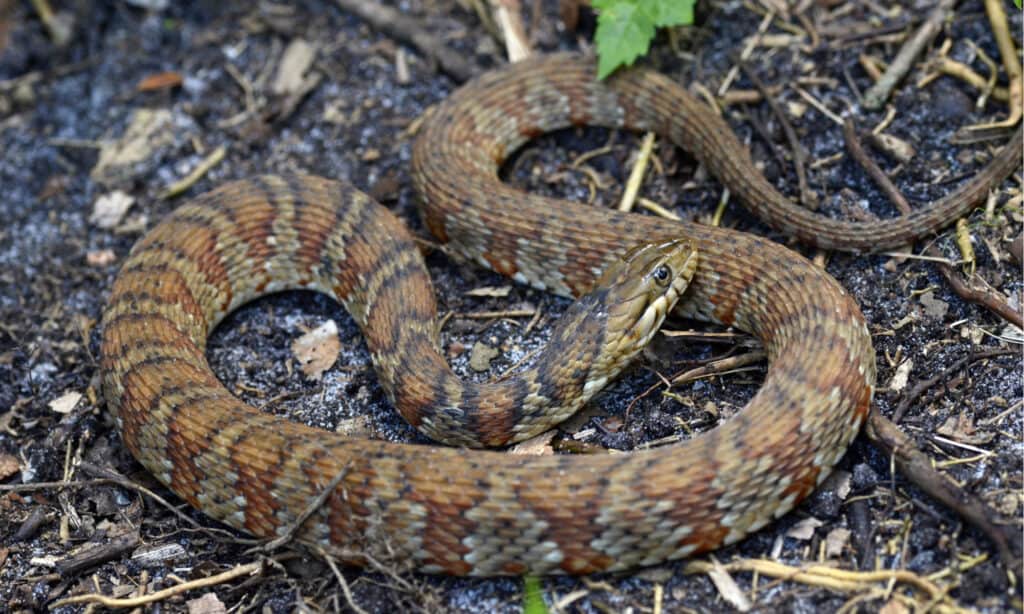
Banded water snakes have dark markings like cottonmouths.
©Patrick K. Campbell/Shutterstock.com
Also known as the southern water snake, the banded water snake is a thick-bodied snake that reaches 24 to 42 inches long. Banded water snakes are typically greenish-grey or brown with dark crossbands. Like the cottonmouth, they can sometimes be so dark that the markings are indistinguishable. However, these snakes typically have a dark stripe or band which extends from the corner of their eye to their jaw.
Mississippi Green Water Snake (Nerodia cyclopion)

The markings on Mississippi green water snake fades as it grows older.
©iStock.com/Shoemcfly
The Mississippi green water snake is 30 to 55 inches long. They have a dark greenish-black body with darker markings that fade as they get older. These snakes prefer still water such as bayous, swamps, and ponds where they prey on fish, crayfish, and frogs.
Up Next
- Discover the 3 Types of Rattlesnakes in Louisiana
- Black Snakes in Louisiana
- Discover the 10 Largest Animals in Louisiana, and Where You’ll Find Them
The photo featured at the top of this post is © KF2017/Shutterstock.com
Discover the "Monster" Snake 5X Bigger than an Anaconda
Every day A-Z Animals sends out some of the most incredible facts in the world from our free newsletter. Want to discover the 10 most beautiful snakes in the world, a "snake island" where you're never more than 3 feet from danger, or a "monster" snake 5X larger than an anaconda? Then sign up right now and you'll start receiving our daily newsletter absolutely free.
Sources
- National Library of Medicine, Available here: https://www.ncbi.nlm.nih.gov/books/NBK546645/
- Live Science, Available here: https://www.livescience.com/43597-facts-about-water-moccasin-cottonmouth-snakes.html#:~:text=%22Like%20all%20pit%20vipers%2C%20%5B,which%20is%20often%20potential%20prey.
Thank you for reading! Have some feedback for us? Contact the AZ Animals editorial team.






